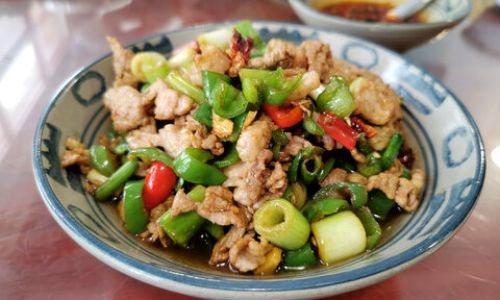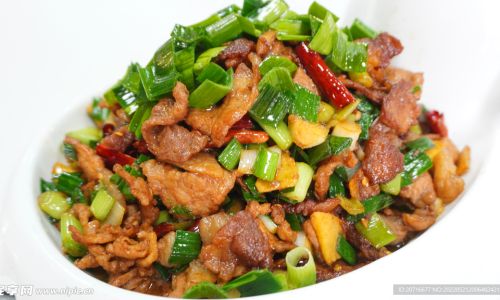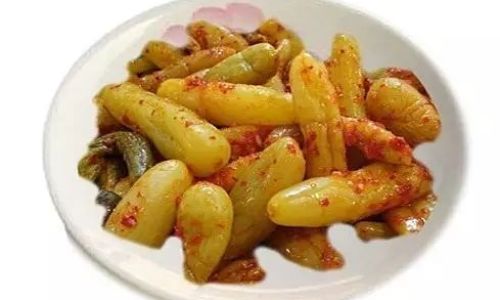Introduction: A Taste of Yunnan’s Culinary Heritage
In the vast culinary landscape of China, regional cuisines stand as testament to the diverse flavors and traditions that have evolved over centuries. Among these, Yunnan cuisine, with its unique blend of Han, Tibetan, Bai, Yi, and other ethnic influences, offers a fascinating array of dishes that are both exotic and comforting. One such dish that encapsulates the essence of Yunnanese cooking is Xuanwei Stir-Fried Pork, a humble yet deeply flavorful plate that has become synonymous with the city of Xuanwei in Yunnan Province.
Xuanwei Stir-Fried Pork, often abbreviated as “Xuanwei Xiaochaorou,” is a dish that combines simplicity with sophistication. Its appeal lies not just in the taste but also in the story it tells—a tale of local ingredients, traditional techniques, and the culinary ingenuity of the Xuanwei people. This article aims to delve into the authentic recipe for Xuanwei Stir-Fried Pork, exploring every aspect from ingredient selection to cooking techniques, and uncovering the secrets behind its distinctive flavor.

The Ingredients: A Perfect Blend of Freshness and Authenticity
Before diving into the cooking process, it’s crucial to understand the ingredients that make Xuanwei Stir-Fried Pork truly authentic. The key lies in the freshness and quality of each component, which together create a symphony of flavors.
-
Pork Shoulder (or Belly): The star of the dish, the pork used should be lean yet marbled with just the right amount of fat. Pork shoulder or belly is preferred as it balances tenderness with a hint of chewiness, adding to the overall texture and mouthfeel.
-
Chili Peppers: Xuanwei is known for its fiery dishes, and chili peppers are a staple. Fresh red or green chili peppers, depending on preference for heat and color, are finely sliced to release their fiery essence during stir-frying.
-
Garlic and Ginger: These aromatic ingredients are essential for adding depth and complexity to the dish. Garlic is minced, while ginger is thinly sliced or julienned.
-
Scallions: Also known as spring onions, these add a fresh, slightly sweet and pungent flavor to the stir-fry. They are cut into short lengths for even distribution.
-
Soy Sauce and Rice Wine: Soy sauce provides saltiness and a subtle umami flavor, while rice wine (Shaoxing wine is ideal) adds a layer of sweetness and aroma. Together, they form the backbone of the sauce.
-
Sesame Oil and Vegetable Oil: Sesame oil, with its nutty aroma, is used sparingly for garnishing, while vegetable oil is the base for stir-frying, ensuring the pork and vegetables don’t stick to the pan.
-
Cornstarch: A small amount of cornstarch is mixed with water to create a slurry, which is used to thicken the sauce at the end, giving the dish a glossy finish.
-
Sugar and Salt: A pinch of sugar balances the soy sauce’s saltiness and enhances the overall harmony of flavors, while salt is adjusted to taste.
-
White Pepper: A dash of ground white pepper adds a subtle heat and aroma, complementing the chili peppers.
The Preparation: A Labor of Love
The preparation of Xuanwei Stir-Fried Pork begins with meticulous attention to detail, ensuring that each ingredient is perfectly prepped before the cooking process begins.
-
Slicing the Pork: The pork shoulder or belly is first chilled in the refrigerator for about an hour to firm up, making it easier to slice thinly. Using a sharp knife, slice the pork into thin strips or shavings, about 1/8 inch thick. This thinness ensures that the pork cooks quickly and evenly, retaining moisture and flavor.
-
Marinating the Pork: In a bowl, combine the sliced pork with a tablespoon of soy sauce, a teaspoon of rice wine, a pinch of salt, and a dash of white pepper. Mix well and let it marinate for at least 15 minutes, allowing the flavors to penetrate the meat.
-
Preparing the Aromatics: While the pork is marinating, mince the garlic, slice the ginger, and chop the scallions and chili peppers. Having these ingredients ready ensures a smooth cooking process.
The Cooking: A Dance of Heat and Flavor

With all ingredients prepped and ready, it’s time to bring the heat and cook the dish. The stir-frying process is quick and requires constant attention to maintain the perfect balance of flavors and textures.
-
Heating the Pan: Place a wok or large frying pan over high heat and add a generous amount of vegetable oil. The oil should be hot but not smoking, ensuring that the pork doesn’t stick and cooks evenly.
-
Stir-Frying the Pork: Once the oil is hot, add the marinated pork strips, spreading them out in a single layer. Stir-fry for about 2-3 minutes, until the pork turns slightly golden and opaque. Be careful not to overcook, as the pork will continue to cook with the other ingredients. Remove the pork from the pan and set it aside on a plate.
-
Sautéing the Aromatics: In the same pan, add a little more oil if needed and reduce the heat to medium. Add the minced garlic and sliced ginger, stirring constantly until fragrant (about 30 seconds). Be careful not to let the garlic burn, as it will turn bitter.
-
Adding the Chili Peppers and Scallions: Quickly add the sliced chili peppers and scallions to the pan, stirring for another minute until they soften slightly and release their flavors.
-
Combining Ingredients: Return the stir-fried pork to the pan, adding any juices that have collected on the plate. Pour in the remaining soy sauce, rice wine, and a pinch of sugar. Stir well to combine, ensuring that all ingredients are evenly coated with the sauce.
-
Thickening the Sauce: In a small bowl, mix a teaspoon of cornstarch with 2 tablespoons of water to create a slurry. Pour this mixture into the pan, stirring constantly, until the sauce thickens and becomes glossy. This should take about 1-2 minutes.
-
Final Touches: Taste and adjust the seasoning with additional salt, if needed. Drizzle a small amount of sesame oil over the dish for a nutty aroma and flavor. Stir once more to combine and remove the pan from heat.
Serving: A Culinary Masterpiece
Xuanwei Stir-Fried Pork is best served immediately, while the pork is still tender and the sauce is hot and glossy. It pairs wonderfully with steamed rice, absorbing the savory juices and enhancing the overall dining experience. For a more complete meal, consider serving it with other Yunnanese specialties such as steamed buns, pickled vegetables, or a simple green salad to balance the flavors.
Conclusion: A Culinary Journey Through Xuanwei
Xuanwei Stir-Fried Pork is not just a dish; it’s a journey through the culinary heritage of Yunnan, a region rich in flavors and traditions. By following the authentic recipe, one can experience the delicate balance of ingredients, the artistry of stir-frying, and the sheer joy of creating a dish that has stood the test of time.
In a world where fast food and convenience often reign, the preparation of Xuanwei Stir-Fried Pork offers a reminder of the beauty of slow, mindful cooking. It’s a dish that celebrates the simplicity of fresh ingredients and the skill of the chef, inviting diners to savor each bite and appreciate the depth of flavor that only authentic Yunnanese cuisine can provide.
As you sit down to enjoy your homemade Xuanwei Stir-Fried Pork, take a moment to reflect on the journey that brought you to this culinary masterpiece. From the careful selection of ingredients to the meticulous stir-frying process, each step has contributed to the final dish, making it a true representation of Yunnan’s culinary spirit.
So, the next time you’re in the mood for a flavorful, satisfying meal, consider whipping up a batch of Xuanwei Stir-Fried Pork. It’s not just a meal; it’s a celebration of tradition, culture, and the art of cooking. Bon appétit!




0 comments